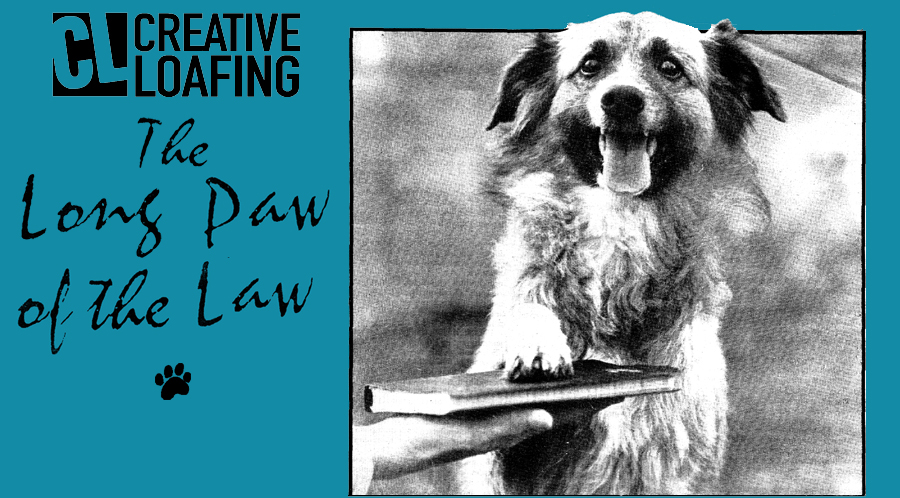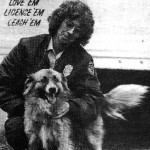
It’s a dog day afternoon in Atlanta Municipal Court for defendants in animal control cases
By Rob. Walton
At 4 a.m. on a Thursday morning, three uniformed police officers descended on the peaceful home of Pam Leonard, rousing her and her husband from their tranquil slumber. There was a warrant for Pam’s arrest.
“This must be some kind of mistake,” Pam argued groggily.
“That’s what they all say, lady,” replied an officer indifferently.
Pam was charged with failure to appear in “dog court.”
Animal control court, informally referred to as “dog court” by pet owners and government secretaries, is held on Friday afternoons in the Atlanta Municipal Court. Here, pet owners charged with violations of Fulton County’s animal control ordinances are tried amidst a riot of shoplifters, child molesters and MARTA fare jumpers.
In Mrs. Leonard’s case, her dog Dolly (a collie) had previously been apprehended by a watchful animal control officer who had sighted the dog running at large. Pam returned from work that evening and was greeted by a pink slip on her doorknob informing her that Dolly was in doggie jail. She picked Dolly up at the Atlanta Humane Society’s Howell Mill Road facility, paid the fine, and was issued a summons to appear in doggie court. When the court date eventually rolled around, Pam simply forgot about it and, consequently, did not go. It was at this point that the judge issued the arrest warrant. Three weeks later, at 4 in the morning (the police officers explained that she was sure to be home at this hour), the authorities paid her a call.
What a great many pet owners do not realize is that even if you intend to plead guilty to your charges and pay the fine, you must still appear in dog court. As a result of this misunderstanding, most people do not even show up, and those that do are quite displeased.
 After her hearing, Eileen Brumback, a young professional who pleaded guilty to “dog running at large,” stomped up to the fine window grumbling about the wasted time. Like nearly everyone else, she understood the penalties for pet violations but was unclear as to why it was necessary for her to appear in court.
After her hearing, Eileen Brumback, a young professional who pleaded guilty to “dog running at large,” stomped up to the fine window grumbling about the wasted time. Like nearly everyone else, she understood the penalties for pet violations but was unclear as to why it was necessary for her to appear in court.
Tad Ransopher, an attorney who has represented clients in animal control trials, likened the procedure to that of a serious traffic offense where a driver charged with, say, excessive speeding is required to appear in court even after paying his ticket; the court wants to make the transgressor aware of just how serious the charges are.
The public tends to take dog court somewhat lightly. Wayne Respress, a field officer with Fulton County Animal Control, confides, “Some people don’t take us seriously. Some people think it’s a joke.” Judging from the remarkably low turnout of doggie defendants on the docket, this is an understatement. Apparently, even a 50 percent turnout is unusually large. Those who choose not to appear are often issued warrants. Respress adds, “We usually get compliance the second time.” Fines of up to $1,000 reemphasize the gravity of the court’s proceedings.
Preventing canine chaos and animal anarchy is the responsibility of Fulton County Animal Control which employs 28 officers (dog catchers) and is under the aegis of the SPC’A and licensed with the Humane Society. Dog catcher Ruth Taylor asserts that unlike other cities “the animals impounded here are treated humanely and with dignity. No experiments are performed on the animals. There are no probes, no shampoo in the eyes, no AIDS testing.” Reaffirming her affinity for animals, Taylor describes how she gently apprehends an offending beast with a large net and gingerly places it in one of the truck’s six compartments. The animals are never hurt.
Animal control officers are not affiliated with the police; they are citizens deputized by the Fulton County Sheriffs Department. Regardless, animal control is a high-risk vocation. In addition to the obvious danger of dog bites and the like, there are human hazards. Officer Tammi Hamilton, 23, on the force for seven months, has already had a gun held to her head by a disgruntled animal enthusiast. Hamilton, who admittedly joined the force because she needed a job, philosophized, “People are very attached to their animals. They get violent when people try to tell them what to do with them.”

Nice Doggy
Hamilton described another nerve-racking incident in which a man “put his hands on [her] and turned [her] around” after she placed his pooch in the back of her truck. Shaken, she called the authorities. “The police gave him a rather stern talking to,” she said.
“It is serious. A lot of people don’t take it seriously. I take it seriously,” recited Hamilton. “If animals are out and loose, they could get hit by a car or bite someone,” she chirped, demonstrating her irrepressible social conscience.
An officer’s typical day is spent responding to calls, issuing warrants and cruising the field looking for animals in violation of the county’s animal ordinances, namely, unregistered or unvaccinated pets, vicious animals and animals at large.
The Atlanta animal control cases are heard Friday afternoons on the second floor of the Decatur Street Municipal Building, just around the corner from Georgia State University. Everyone entering the facility must first pass through a metal detector in the first-floor lobby and again before entering the courtroom.
The courtroom itself is dismal and institutional with graying walls, hard wooden pews and a prominent, scuffed Plexiglas booth where dangerous criminals to be tried for violent crimes are held. The judge’s podium at the front of the room is flanked authoritatively by the Georgia flag on the right and the American flag on the left.
Although it was mortally cold outside, the courtroom was oppressively hot and humid. Thankfully, the room’s one tiny window was cocked open to circulate some air. A group of animal control officers sat leisurely at the front of the room. The defendants trickled into the courtroom, eyes lowered, and sidled into the vacant pews. Some silently shook their heads in remorse. Others fidgeted nervously, while others glared in agitation. A woman in the front row smartly masked her uneasiness with a subtle yawn as she balanced her checkbook.
A state corrections officer escorted a group of tight-lipped, dangerous criminals into the Plexiglas booth where they sat slouched back in their seats, feigning indifference.
Once the courtroom settled, the stout, no-nonsense bailiff barked that there should be no talking, no eating and no reading of newspapers in the courtroom. He clasped his hands behind his back and leered over the courtroom.
Before long, a smartly dressed woman breezed into the room with the perky, confident stride of a Charlie girl. Assistant City Solicitor Elaine Carlisle took her place in front of the bench to play the part of prosecutor, providing counsel to the animal control officers.
The court clerk called roll.
With a minimum of fanfare, Judge Catherine E. Malicki took the bench, and the hearings began with a seemingly endless parade of violators explaining to the judge why their dogs weren’t wearing tags or why they were wandering freely about the neighborhood. Because of her strict adherence to the law, Judge Malicki may not be a favorite among pet transgressors, but from her unorthodox approach to administering justice, it is obvious that she is genuinely concerned with the welfare of pets.
 Ron Totten, administrative assistant in charge of field services for Animal Control explains: “Malicki is unique in that she offers most animal owners the opportunity to be responsible for their pets. It goes beyond guilty and not guilty. She bases judgments on how she feels about the owners.”
Ron Totten, administrative assistant in charge of field services for Animal Control explains: “Malicki is unique in that she offers most animal owners the opportunity to be responsible for their pets. It goes beyond guilty and not guilty. She bases judgments on how she feels about the owners.”
Malicki agreed to waive one gentleman’s dog-at-large fine after he consented to walk the lonely pet at least three times a day. Other judgments passed in lieu of a fine included the lengthening of a rambunctious puppy’s tether and the fencing in of another’s back yard. In an attempt to prevent future transgressions, Malicki suggested a foolproof way to keep unruly pets from digging out under the fence using only a piece of wire.
Malicki is often sympathetic. When poor Lorretta Kathy Gordon was charged with “dog running at large,” she explained that she had been in control of her dog until it saw the dog catcher and took off. Malicki empathized, “I know. When dogs see that Animal Control truck coming, they run straight the other way. $35. Ten days suspended upon payment of fine.” Whack.
Almost all of the cases concerned dogs: dogs running at large, dogs without tags and vicious dogs. It seems cats are curiously exempted from nearly every ordinance and, therefore, are virtually immune to incarceration unless one actually bites someone. Occasionally, there are cases involving livestock running at large. Such cases are whimsically nicknamed “cattle calls.”
The “at large” and “no tag” cases are generally cut and dry and settled quickly. (Either your dog is registered or he isn’t.) Occasionally, though, there are “vicious dog” cases, and these can become emotional. According to city ordinances, a “vicious dog” is “any dog which attacks, bites or injures humans or other animals without provocation; or which, because of temperament, conditioning or training, has a known propensity, tendency or disposition to attack, bite or injure other living creatures without provocation … ” There is an ambiguous addendum to the definition which includes “canines who chase or approach a human being upon the street, sidewalk or any public grounds in a vicious or terrorizing manner in an apparent attitude of attack.” These cases are the most entertaining because they involve two parties with radically different points of view.
In one such case, Lynda Porter’s dog Max, a medium-sized mutt, was cited with eight offenses including “vicious dog.” A neighbor had called Animal Control when Porter’s dog allegedly came onto his property and growled menacingly at his two dogs. Tensions in the courtroom mounted when, in a desperate attempt to save her mutt from the muzzle, Porter alleged that the other dogs had instigated the trespassing and growling incidents by repeatedly coming onto her property and eating her dog’s food (cleverly alluding to provocation). The odds seemed to be stacked against Porter, until her perfectly’ timed disclosure that the allegedly victimized dogs were a pit bull and a large Doberman pinscher. Porter was sentenced to only a minimal fine.
Attorney Tad D. Ransopher, who has spent a good deal of time recently in doggie court, recalled a dramatic day in state dog court (where trials of those offenses which take place in Fulton County outside of the Atlanta city limits are held). His client, Ms. Stillman, charged a neighbor, Mr. Johnson, with cruelty to animals when he kicked her dog for allegedly barking at his cat. Johnson responded by filing charges against Stillman for having a vicious dog. On Dec. 5 the two parties faced off in the Magistrate Court of Fulton County.
Ransopher argued that Johnson’s charge against Stillman was retaliatory, informed the judge that there were outstanding warrants for the man’s arrest and alleged that the defendant had a history of cruelty to animals. When asked for proof of the latter allegation, Ransopher produced witnesses who testified that Johnson had shot their dog. Stillman’s charges were dismissed. Johnson, however, was charged with two counts of’ cruelty to animals ($1,000 in fines) and was arrested on an unregistered weapons charge. Johnson was in the doghouse.
Regardless of where the cases are heard, the doggie courts do reform doggie criminals. Pam Leonard, after being served at 4 in the morning, vows she will never have to face dog court again; the following day she transferred Dolly the collie’s registration to her husband’s name.
![]()